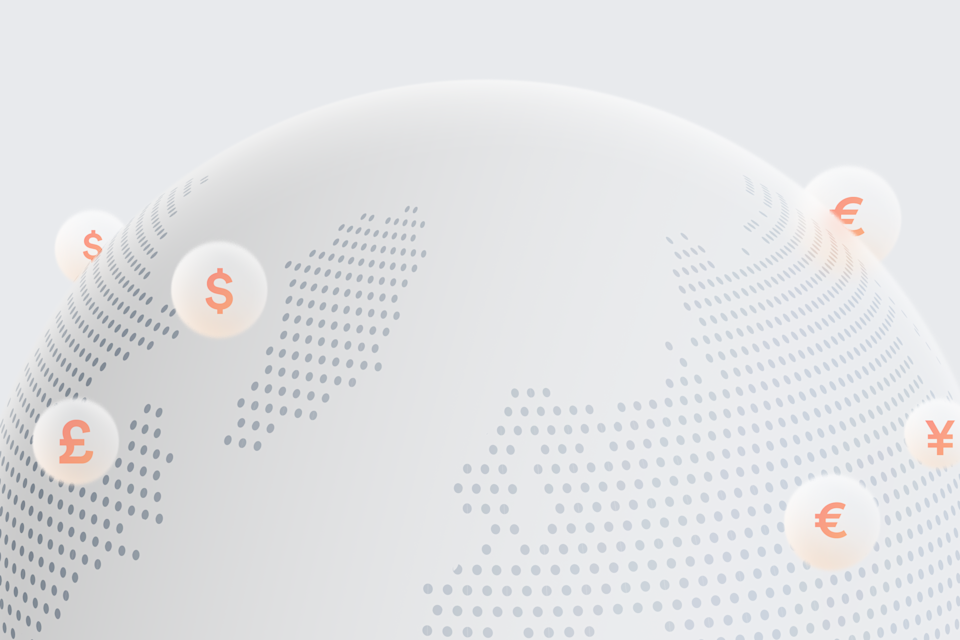Key takeaways:
International transaction fees associated with cross-currency transactions and conversions that are typically 1% - 3% of the value of the transaction.
There are three key types of foreign transaction fees: currency conversion, dynamic currency conversion, and payment network fees (cards).
Multi-currency accounts and cards can help you save on fees or avoid them altogether.
These days, almost every business is, in one way or another, a global business. Whether you’re selling internationally, using global services or acquiring supplies from abroad – your finances are touching different corners of the world. Foreign transaction fees seem inevitable, but these can be slow and expensive, impacting cash flow and profit margins.
Once you know how to minimise foreign currency exchange costs and hidden fees, you can better plan your business finances to avoid them. Let’s explore how savvy businesses can save on overseas spending.
What is an international transaction fee?
An international or foreign transaction fee is a charge that financial institutions add when you make payments in foreign currencies or through overseas banks. This charge is usually between 1% and 3% of the transfer amount, and it should be stated in the financial institution’s terms and conditions.
Money moves so seamlessly across borders now that it’s easy to forget the complicated picture going on behind the scenes. Countries and regions around the world have their own rules and regulations around financial transactions, and banks need to communicate to move the payment from one account to another.
The financial institutions managing these processes incur operational expenses that are then passed on to you as various foreign transaction fees.
The most common foreign transaction fees your business may encounter include:
Currency conversion fees
You may incur currency conversion charges when making international transfers, where you need to change your currency into the currency of the recipient. This is typically around 1-4% of the total amount.
Direct bank-to-bank international wire transfers can incur hefty transaction fees. While the SWIFT payment network is a relatively efficient method of sending money overseas, it comes with charges from any intermediaries that the money may pass through before it reaches its destination.
Make your first transfer with an Airwallex Business Account.
Dynamic currency conversion fees
Some businesses offer fees that change the exchange rate. These fees let you pay an international supplier in SGD instead of the currency they use.
While you think you’re avoiding foreign transactions, you may still be charged a fee – in this case, a fee for a third party undertaking the conversion. When using this method, keep an eye on the exchange rate on offer, as it’s usually significantly less than the real interbank FX rate.
Credit card and payment network fees
These fees cover the conversion cost from all parties involved – namely, from your bank, the recipient’s bank, and the payment network that was used in this transaction.
Institutions typically charge 1-3%, but banks are also known to charge high flat-rate fees for these payments, between S$6-$30 per transaction. If you make a lot of international payments, this adds up fast. Especially when you consider additional payment transaction costs like interchange fees.
What do foreign transaction fees mean for businesses?
Businesses can be impacted by currency conversion costs and fluctuating FX rates in all cross-border transactions, including collecting money from customers, paying employees, and buying supplies.
Being aware of the factors driving currency volatility can help businesses avoid sudden hits to their profit margin. Foreign exchange (FX) rates are fluctuating constantly, thanks to changes like:
Inflation rates: Lower rates of inflation are correlated with a country having greater purchasing power compared to its trading partners, which affects FX rates.
Interest rates: Higher interest rates tend to attract foreign capital seeking higher returns, leading to currency appreciation.
Economic indicators: GDP growth, employment rates and manufacturing output reflect a strong economy.
Political instability: This can negatively impact the value of a country’s currency, as it can put off potential foreign investors due to increased uncertainty and decreased confidence.
Trade balances: Countries that export more than they import generally experience an appreciation of their currency.
Example: A company’s home currency falls in value, so the cost of wages and supplies in other countries rises. Holding funds in foreign currencies can help counterbalance this effect.
On the other hand, if a company’s home currency strengthens, these costs will have less of a financial toll. However, the price of the business’s products may become less competitive in foreign markets, leading to a potential loss of market share.
Exchange rate fluctuations also impact financial reporting. The perceived financial health of the company may be impacted if the company’s home currency drops in value. By monitoring changes in FX rates, companies that hold money in multiple currencies can also make effective decisions about when to move money between accounts.
3 ways to avoid foreign transaction fees
From low-FX direct telegraphic transfers to multi-currency wallets and low-fee business cards, here are a few ways you can save on foreign business transactions.
Hold multiple currencies and eliminate unnecessary conversions
If you’re doing business across borders but only have the capacity to hold money in your home currency, you’re missing out. A foreign currency account is a great way to manage foreign exchange risk for your business.
With Airwallex’s Global Accounts for business, you can hold funds in multiple currencies, and each account operates as though you were a local of that country.
This means you can collect payments from your international customers in their preferred currency and then spend those proceeds later in the same currency. For example, you can use held funds to pay global suppliers and employees.
On the other hand, a domestic bank account may forcibly convert funds in and out of your home currency with every cross-border transaction, incurring costly FX fees in both directions.
It’s important you know what you’re looking for and how to compare business bank accounts when identifying the best account for your business operations.
Use a card with no foreign transaction fees
There are also cards designed for international business transactions that minimise FX fees for fast, efficient spending.
Airwallex Borderless Cards are multi-currency international business debit cards, so you can use them to pay for international expenses without incurring FX fees, as long as you have the correct currency balance in your account.
If you don’t have the correct currency available in your account, you’ll benefit from Airwallex’s market-leading FX rates.
Airwallex Borderless Cards come with three major benefits:
Avoid unnecessary currency conversion by holding funds in different currencies to reduce the need for conversions when you pay out in the same currency.
Increase business expense transparency by viewing transactions in different currencies in one account with a centralised view.
Enjoy global acceptance with the Visa payment network, allowing you and your team to make payments anywhere in the world.
Travel with cash or multi-currency cards and avoid ATMs
If you do a lot of business travel, plan ahead and convert your cash before you get to the airport to save.
ATMs charge expensive fees you’ll want to avoid once you land in another country. Otherwise, you’ll owe conversion fees, as well as fees from your bank and the ATM provider (assuming it’s not tied to your bank). And your bank at home will likely offer a better conversion rate, anyway.
However, most business isn’t done in cash, and it’s a security risk to carry too many bills at once. So, a multi-currency business card or global business account is still likely your best bet. You can even get virtual cards for convenient access on the go.
How are foreign transaction fees calculated?
Most foreign transaction fees are percentage-based charges, so the actual fee amount varies based on the transaction size. Though, some banks use flat-rate fees.
A total foreign transaction fee averages 1-3% of your transaction. So if you pay an international employee S$3,000, you’d owe between S$30-$90 in foreign transaction fees.
The actual rate you pay depends on the type of foreign transaction fee charged and the rate your chosen institution charges.
Explore easy, foreign transaction fee-free business accounts
Knowing how to avoid international transaction fees isn’t just about cost savings. Steps like leveraging multi-currency accounts can certainly help save money, especially if you make a high volume of international payments.
However, you also enjoy the added benefit of faster transactions to improve cash flow management with accurate data for financial planning. Quick transactions also make sure you never miss a payment for improved service and reduced late fees.
Avoid fees with local payment rails.
Sources:
https://www.beuc.eu/sites/default/files/publications/beuc-x-2017-131_currency_conversion_scam_factsheet.pdf
View this article in another region:AustraliaCanada - EnglishCanada - FrançaisMalaysiaNew ZealandUnited StatesGlobal

Shermaine Tan
Manager, Growth Marketing
Shermaine spearheads the development and execution of content strategy for businesses in Singapore and the SEA region at Airwallex. Leveraging her extensive experience in eCommerce, digital payment solutions, business banking, and the cross-border industry, she provides invaluable insights that guide businesses through the complexities of global commerce. Specialising in crafting relevant and engaging content that resonates with business owners, her work is designed to drive growth and innovation within the fintech and business economy space.
Posted in:
Transfers

